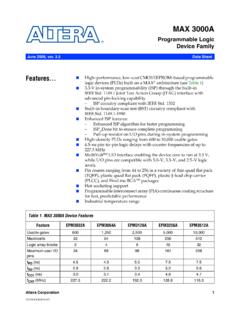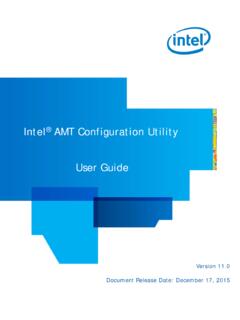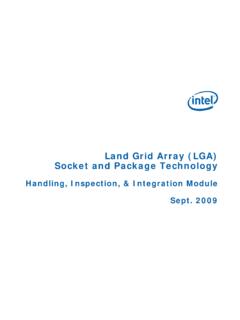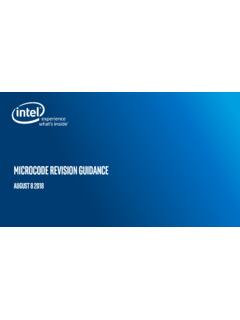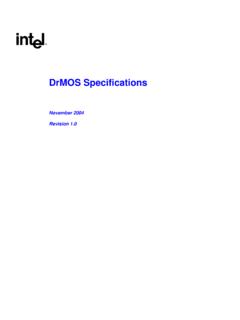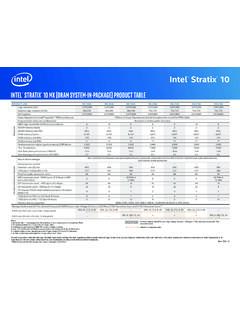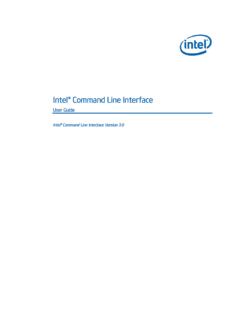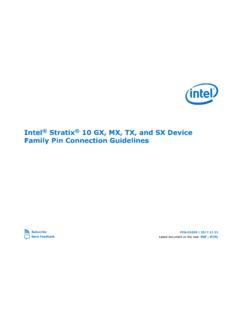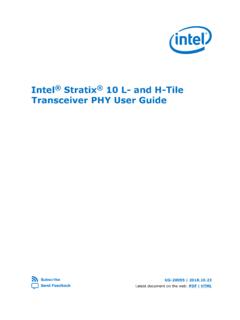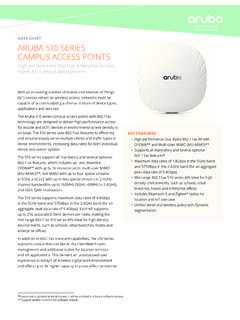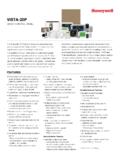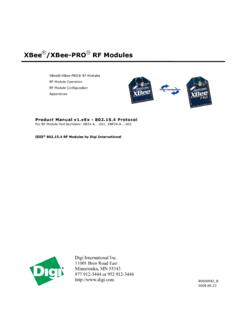Transcription of Define IEEE 802.11 and other Wireless LAN Standards - Intel
1 Helping Define IEEE and other Wireless LAN Standards IEEE Wireless local area networks Intel is a longtime contributor to the IEEE standard, a group of specifications developed by the Institute of Electrical and Electronics Engineers (IEEE) for Wireless local area networks (WLANs). Much of the current work on IEEE centers on increasing transmission speeds and range, improving Quality of Service (QoS), and adding new capabilities. Now that IEEE , the latest version of IEEE , is shipping in volume, the focus is on even faster solutions, specifically IEEE and IEEE These amendments aim to provide gigabit speed WLAN. The difference is their frequencies. IEEE will deliver its throughput Quality of Service (QoS) In computer networking, QoS doesn't over the 5 GHz band, affording easy migration from IEEE refer to achieved service quality , which also uses 5 GHz band (as well as the though it plays an important role in it. band). IEEE , targeting shorter range Instead, QoS is about using resource transmissions, will use the unlicensed 60 GHz band.
2 Reservation control mechanisms to give different priority to different applications, Through range improvements and faster Wireless users, or data flows to ensure a certain transmissions, IEEE and ad will: level of performance. For example, a particular bit rate, along with limits on Improve the performance of high definition TV delay, jitter, and packet dropping probability and/or bit error rate, may be (HDTV) and digital video streams in the home and guaranteed for a real time streaming advanced applications in enterprise networks multimedia application such as an online Help businesses reduce capital expenditures by game or video. For such delay sensitive freeing them from the cost of laying and applications, QoS guarantees are maintaining Ethernet cabling important, when network capacity is insufficient for all the concurrent data Increase the reach and performance of hotspots flow ( , the video and other less Allow connections to handle more clients sensitive applications such as email and Improve overall user experience where and web browsing).
3 Whenever people are connected The IEEE Working Group (WG) consists of individuals who are experts in Wireless technology and includes a number of Intel employees. Intel sees IEEE as vital to continuing to improve and expand the Wireless experience of many devices using its products. This case study takes a brief look at the history of IEEE , current efforts to improve the standard, and potential improvements in the future. A short history of IEEE , or Wi Fi as it is popularly known, sprang into Did you know? existence as a result of a decision in 1985 by the United The term "Wi Fi" was invented by the States Federal Communications Commission (FCC) to organization now known as the Wi Fi open several bands of the Wireless spectrum for use Alliance. The term "IEEE . compliant" was considered too long and without a government license. These so called "garbage hard for consumers to remember for bands" were allocated to equipment such as microwave consumers. "Wi Fi" meant nothing at the ovens which use radio waves to heat food.
4 To operate in time, but sounded like "hi fi," a familiar electronics term. Later, the meaning " Wireless fidelity" was attached to Wi Fi. 1 these bands though, devices were required to use "spread spectrum" technology. This technology spreads a radio signal out over a wide range of frequencies, making the signal less susceptible to interference and difficult to intercept. In 1990, a new IEEE committee called IEEE Wireless LAN Throughput by IEEE Standard was set up to look into getting an open standard Media Access started. Demand for Wireless devices was so high IEEE Over the Air Control Layer, that by the time the standard was published in WLAN Service Access 1997, devices adhering to the new standard were (OTA) Estimates Standard Point (MAC SAP) already shipping. Estimates IEEE Developed under the rules of the IEEE (commonly 11 Mbps 5 Mbps pronounced as I triple e ), the IEEE standard defines an over the air interface between 25 Mbps (when IEEE a Wireless client and a base station (or access 54 Mbps.))
5 11b is not present) point), or between two or more Wireless clients. As capabilities are added to the IEEE , some IEEE become known by the name of the amendment. 54 Mbps 25 Mbps For example, many people recognize IEEE , IEEE IEEE and IEEE as popular Wireless Up to 600 Mbps Up to 400 Mbps solutions for connecting to networks. Each of these amendments defines a maximum speed of Up to 867 Mbps Up to 600 Mbps with 2 antennas with 2 antennas operation, the radio frequency band of operation, IEEE how data is encoded for transmission, and the and 80 MHz; Up and 80 MHz; Up to Gbps with to 900 Mbps characteristics of the transmitter and receiver. 3 antennas and with 3 antennas 80 MHz and 80 MHz The first two variants were IEEE (which operates in the industrial, medical and scientific . At least Gbps Up to 700 Mbps ISM band of GHz), and IEEE , which (up to Gbps in IEEE for Gbps OTA operates in the available 5 GHz bands ( some first (up to 3 Gbps for generation Gbps OTA) GHz, GHz, and GHz).
6 A products) third variant, IEEE , was ratified in June 2003. Both IEEE and IEEE use a more advanced form of modulation called orthogonal frequency division multiplexing (OFDM). Using OFDM in the GHz band, IEEE achieves speeds of up to 54 Mbps. The advent of IEEE In the constant quest for greater transmission speed, a High Throughput standardization effort was launched, and IEEE , ratified in October 2009, became the fourth IEEE variant. Intel product groups and Intel research and development employees contributed to the development of the IEEE standard from its beginning to completion, playing major roles in the IEEE Task Group and providing technical assistance. IEEE leveraged many important specifications of its predecessors, but also introduced significant 2 advancements in Wireless technology. Some of Intel 's contributions included the development of channel models, usage models, functional requirements, and comparison criteria. Intel employees also helped Define key modifications to the Physical Layer and Media Access Control Layer (PHY/MAC) and develop performance measurement methodologies and simulation methodologies.
7 IEEE approximately quadruples WLAN throughput performance compared to IEEE networks. Its support for multiple antennas provides better range at given throughputs and improved, more uniform service within the coverage of a basic service set (BSS). Using multiple antenna systems for both the transmitter and the receiver is referred to as multiple input multiple output (MIMO) or a smart antenna system (see Figure 1). Intel contributed much research to MIMO. By employing multiple diverse antennas tuned to the same channel, Basic Service Set (BBS) each transmitting with different spatial characteristics, A BBS is the basic building block of an IEEE WLAN. A BSS consists of a MIMO uses spectrum more efficiently without sacrificing single access point (AP), together with all reliability. Every receiver listens for signals from every associated devices, such as a laptop, transmitter, enabling path diversity where multi path smart phone and HDTV. This is not to be reflections (normally disruptive to signal recovery) may confused with the coverage of an access be recombined to enhance the desired signals.
8 Point, which is called basic service area (BSA). MIMO technology also uses Spatial Division Multiplexing (SDM). SDM spatially multiplexes multiple independent data streams (essentially virtual channels) simultaneously within one spectral channel of bandwidth. Having multiple antennas simultaneously send different flows of individually encoded signals (spatial streams) over the air shoves more data through a given channel. At the receiving end, each antenna sees a different mix of the signal streams and the device "demultiplexes" them to use them. MIMO SDM can significantly increase data throughput as the number of resolved spatial data streams is increased. Each spatial stream requires its own transmit/receive (TX/RX) antenna pair at each end of the transmission. Figure 1. Diagram showing how a smart antenna system enables multiple input/multiple output (MIMO). An important tool in IEEE for increasing the physical transfer rate is wider bandwidth spectral channels, also known as channel bonding.
9 Using a wider channel bandwidth, in combination with OFDM, offers significant advantages in maximizing performance. Wider 3 bandwidth channels are cost effective and easily accomplished with moderate increases in digital signal processing (DSP). If properly implemented, doubling the legacy bandwidth of IEEE channels from 20 MHz to 40 MHz can provide greater than two times the usable channel bandwidth. Coupling MIMO architecture with wider bandwidth channels offers the opportunity of very powerful, yet cost effective approaches for increasing the physical transfer rate. The use of these technologies in IEEE enables a WLAN to achieve up to 300 Mbps. Designs employing four antennas tuned to the same channel each transmitting a different spatial stream at a channel width of 40 MHz are capable of even delivering up to 600 Mbps. The development of 802ac and IEEE In a world hungry for mobile devices capable of simultaneously handling high definition (HD) streaming video, voice over IP (VoIP) calls, web page delivery, and fast data transfers, IEEE is fast, but still not fast enough to keep up with people's desire for higher performance, particularly in video streaming and game play, and for handling the growing number of devices connecting to an AP.
10 What's more, the enormous popularity and success of Wi Fi continues to create new challenges, many of which could be attributed to the need to cope with the technology's overwhelming its success. In addition to speed, these challenges include providing According to In Stat, mobile devices with Wi Fi will account for around 800 million greater bandwidth and better handling of channel units by 2015. It's expected that 100 contention. percent of mobile hotspot shipments by that date will support IEEE Foreseeing these challenges, the IEEE WG in 2007 formed the Very High Throughput (VHT) study group to work on the next generation IEEE One goal was to increase throughput to at least 1 Gbps to be shared by devices connected to an AP in the under 6 GHz band, with the capability for a single link to operate at 500 Mbps. The second goal was single link performance of at least 1 Gbps in the 60 GHz band. IEEE and IEEE were the two interfaces targeted for development for VHT operation. All WLAN Standards depend on access to radio spectrum.
